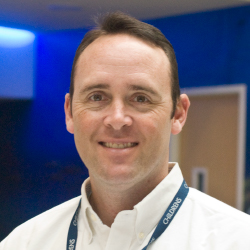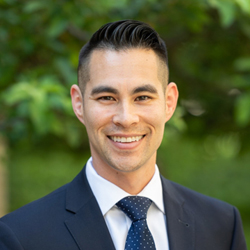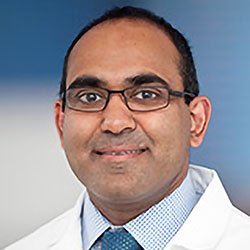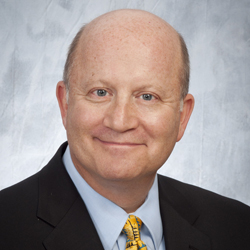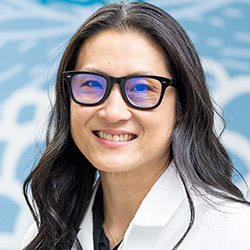Endoscopic Strip Craniectomy
What is endoscopic strip craniectomy?
An endoscopic strip craniectomy is a surgery to remove a fused suture in babies with some types of craniosynostosis. After surgery, your baby wears a helmet for several months. The helmet molds their head to a shape and allows for normal brain growth.
This less invasive procedure is also called endoscopic release surgery. During the operation, surgeons use an . This is a thin, lighted tube with a camera and small tools attached.
Much smaller cuts are made to the baby’s head and scalp in endoscopic surgery than in traditional (open) surgery.
See craniosynostosis treatments to learn about all treatment options for babies with fused sutures. We base our recommendations on the affected suture and your baby’s age.
How does endoscopic strip craniectomy work?
An experienced craniofacial plastic surgeon and a neurosurgeon work as a team in the operating room.
- The craniofacial plastic surgeon makes 2 small cuts in the top of your baby's head to separate the skin and other soft tissue from the bone underneath. Each cut is about 1 inch (3 cm).
- While protecting the brain, the neurosurgeon makes small holes in the skull or enters the skull through your baby's soft spot.
- Using a small tool on the endoscope, the neurosurgeon separates the skull bone from the protective covering of the brain.
- The surgeons remove the fused suture on the top of your baby’s head.
- They cut out 2 small strips of bone on each side of the skull near the ears.
- The surgeons cut the strips into pieces and put the pieces back into places where bone was removed. This helps in healing. Over time, the pieces of bone will grow together to protect your baby’s brain.
- The surgeons stitch the incisions closed. The stitches will absorb into the body over several days.
After the surgery, most babies spend 1 night in the intensive care unit (ICU). On the second night they are in a regular hospital room. Then they go home in 2-3 days.
The endoscopic surgery and hospital stay are shorter than with open surgery. Because the cuts are much smaller, there is less bleeding. It is less likely that your child will need a blood transfusion.
Helmet therapy
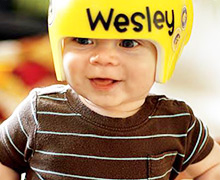 About 2 weeks after surgery, your baby will start wearing a soft helmet. It puts gentle pressure on their skull.
About 2 weeks after surgery, your baby will start wearing a soft helmet. It puts gentle pressure on their skull.
The helmet molds their head to a more normal shape that can expand as their brain grows. This part of the treatment is called helmet therapy or cranial orthotics.
You will meet with an before surgery to learn how the helmet works and how to use it. We either refer to our orthotists or a community-based orthotics program that is experienced with this treatment.
Custom-made helmet
About 10 days after surgery, the orthotist will do a laser scan to create a picture of your baby's head. Then we make a custom helmet. The helmet is ready in about a week. We check to make sure it fits well.
At follow-up visits to Seattle Children’s every 1 to 2 weeks, we check that the helmet is molding your baby’s head the right way.
Families who do not live in the Seattle area may use an orthotist in their local area to make and fit a helmet. Their follow-up visits at Seattle Children’s happen once a month.
Babies wear the helmet for 3 to 12 months. Some babies need a new helmet after about 6 months to keep up with the growth of their head.
Your baby will wear the helmet all the time (23 hours a day), except when bathing.
Who can benefit from endoscopic strip craniectomy?
An endoscopic strip craniectomy is a treatment option only for babies who are 4 months or younger. After this age, the head is not growing as fast, so the helmet is not likely to work as well.
We recommend endoscopic surgery for young babies with a single fused sagittal or lambdoid suture.
We will work with you to determine the best choice for your child and family. See craniosynostosis treatments to learn about all options for babies with closed sutures.
The choice that is right for your family
Even if endoscopic surgery is an option, you can choose open remodeling surgery for your baby instead. The open method also works well to reshape the head. It does not require a helmet afterwards.
We offer both types of surgery because we want families to be able to choose the option that makes the most sense for them. Our team is experienced and comfortable performing both procedures.
The best method is what works for your baby and your family. Our surgeons and social workers can give you information and support to help you decide which is right for you.
What is Seattle Children’s experience with endoscopic strip craniectomy?
We began offering endoscopic strip craniectomy in January 2012 after evaluating its safety and effectiveness. When doing the endoscopic surgery, our team uses the same skills and technology as we have for many years in other surgeries on babies’ heads.
Our team has more experience treating craniosynostosis than any other program in the United States. Each year, we care for more than 400 children with craniosynostosis. Our expertise and experience help us determine which babies are most likely to benefit from endoscopic strip craniectomy.
Our team at Seattle Children's designed one of the first molding helmets for children with “flat head syndrome” (positional plagiocephaly). We use the same principles to design helmets for our patients after endoscopic craniectomy.
Who is on the endoscopic craniectomy team?
The entire Craniofacial team at Seattle Children's helps you and your family through the surgery, hospital stay and follow-up visits.
Before surgery, you see a craniofacial pediatrician. This doctor checks your baby's condition and talks with you about treatment options.
During the operation, a plastic surgeon and a neurosurgeon work as a team.
Team
Craniofacial plastic surgeons
A craniofacial orthotist will create a custom helmet for your child and help you understand how to use it.
Both your plastic surgeon and neurosurgeon take part in your baby's follow-up visits to make sure the helmet is working well.
Support for your whole family
We connect you with other healthcare team members based on your baby's and family's needs. All families who are deciding on surgery for craniosynostosis meet with a social worker from the Craniofacial Center.
Your social worker can help with topics such as:
- Asking the surgeons questions, talking about concerns and thinking about which surgery to choose
- Planning so that treatment goes as smoothly as possible for your family
- Coping during treatment, including getting your child to wear their helmet
- Dealing with time off work to come to surgery and follow-up visits
- Getting resources to travel from home to the hospital
- Dealing with your insurance and any worries about costs
Contact Us
Contact the Craniofacial Center at 206-987-2208 for an appointment, a second opinion or more information.

